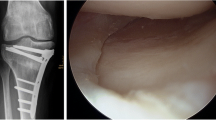Summary
The tissue compatibility of metal implants used in osteosynthesis of human tibial fractures (combination: steel/steel; titanium/steel; titanium/titanium) was studied.
The reaction of the metal-surrounding connective tissue depends on the kind of metal:
-
1.
Lympho-plasmacellular infiltration of the connective tissue: With the aid of morphometry an increased immigration of lymphocytes and plasma cells in the metal-surrounding connective tissue was observed in the case of steel/steel and titanium/steel combinations. This seems to be provoced by the cytotoxicity of the metallic elements characterising the steel combinations. This cytotoxicity produces a slight inflammation stimulating the small lymphocytes.
-
2.
Stimulation of the fibro-histiocytic elements: The titanium/titanium combinations seem to be of a smaller cytotoxicity, since their lympho-plasmacellular infiltrates are smaller than those of the steel combinations. Therefore, in the metal-surrounding connective tissue titanium/titanium combinations shows a higher numerical density and larger nuclei of the fibro-histiocytic elements than that of steel combinations.
This morphometric analysis confirms the result of the animal experiments in sheep which show that the osteosynthesis material of titanium is of better tissue compatibility than that of steel.
Zusammenfassung
Bei der Osteosynthese von menschlichen Unterschenkelfrakturen verwendete Metallimplantate (Osteosynthesematerial) der Kombinationen Stahl/Stahl, Titan/Stahl, Titan/Titan wurden auf ihre Gewebeverträglichkeit untersucht.
Die Metallimplantate üben auf das sie umgebende Bindegewebe je nach Metallart verschiedene Reaktionen aus:
-
1.
Lympho-plasmacelluläre Infiltration des Bindegewebes: Mit Hilfe der morphometrischen Analyse konnte festgestellt werden, daß die Metallimplantate der Kombinationen Stahl/Stahl und Titan/Stahl (Platte/Schraube) im metallumgebenden Bindegewebe ein vermehrtes Einwandern von Lymphocyten und Plasmazellen hervorrufen. Dieses scheint durch den cytotoxischen Effekt der in den Stahlkombinationen enthaltenen Metallelemente verursacht zu werden. Diese Cytotoxicität löst in geringem Maße einen Entzündungsprozeß aus, wobei es zu einer Stimulation der kleinen Lymphocyten kommt.
-
2.
Stimulation der fibro-histiocytären Zellelemente: Die reinen Titankombinationen scheinen eine geringere Cytotoxicität aufzuweisen, da bei diesen die lympho-plasmacelluläre Infiltration viel kleiner ist als bei den Stahlkombinationen. Deshalb findet sich bei den reinen Titankombinationen im metallumgebenden Bindegewebe eine größere Anzahldichte und eine größere mittlere Kerngröße der Fibrocyten (blasten) und Histiocyten als bei den Stahlkombinationen.
Vorliegende morphometrische Untersuchungen bestätigen zusammen mit den Tierversuchen am Schaf, daß das Osteosynthesematerial aus Titan gewebefreundlicher ist als die bisher verwendeten Stahllegierungen, die eine größere Gewebetoxicität aufweisen als Titan.
Similar content being viewed by others
Literatur
Altschuler, C. H., Bareta, J.: On fibroblast metabolism in connective tissue disease. Meth. Achievem. exp. Path. Vol. 1, pp. 218–244, Bajusz, C., Jasmin, G., Eds. Basel-New York: Karger 1966
Bader, G., Bader, N. G.: Karyometrische Untersuchungen der Leberzelle in der chronischen Thioazetamidintoxication und bei zusätzlicher partieller Hepatectomie. Beitr. Path. 149, 111–120 (1973)
Chayen, J., Bitensky, L.: Cell injury. In: Cell biology in medicine, Bittar, E., Ed., pp. 595–663. New York-London-Sydney-Toronto: John Wiley and Sons 1972
Konwinski, M., Kozlowski, T.: Morphometric study of normal and phytohemagglutinin-stimulated lymphocytes. Z. Zellforsch. Abt. Histochem. 129, 500–507 (1972)
Lima, L., Macreira-Coelho, A.: Parameter of aging in chicken embryo fibroblasts cultivated in vitro. Exp. Cell Res. 70, 279–284 (1972)
Page, R. C., Schroeder, H. E.: Biochemical aspects of the connective tissue alterations in inflammatory gingival and periodontal disease. Int. dent. J. 23, 455–469 (1973)
Riede, U. N., Ruedi, Th., Rhoner, Y. L. E., Perren, S., Guggenheim, R.: Quantitative und morphologische Erfassung der Gewebereaktion auf Metallimplantate (Osteosynthesematerial). I. Tierexperimente (Schaf). Arch. orthop. Unfall-Chir. 78, 199–215 (1974)
Schroeder, H. E., Lindhe, J., Hugoson, A., Muenzel-Pedrazzoli, S.: Structural constituents of clinically normal and slightly inflamed dog gingiva. A morphometric study. Helv. odont. Acta 17, 83 (1973a)
Schroeder, H. E., Muenzel-Pedrazzoli, S., Page, R.: Correlated morphometric and biochemical analysis of gingival tissue in early chronic gingivitis in man. Arch. oral Biol. 18, 899–923 (1973b)
Schroeder, H. E., Page, R.: Lymphocyte-fibroblast interaction in the pathogenesis of inflammatory gingival disease. Experientia (Basel) 28, 1228–1230 (1972)
Ward, P. A.: Inflammation. In: Principles of pathobiology, pp. 96–132, La Via, M. F., Hill, R. B., Eds. New York-London-Toronto: Oxford University Press 1971
Weibel, E. R.: Stereological principles for morphometry in electron microscopic cytology. Int. Rev. Cytol. 19, 235–302 (1969)
Weissmann, G., Hirschhorn, R.: The lysosomal system in lymphocytes from cyclic AMP to gene activation. In: Advances in cytopharmacology, Vol. I, pp. 191–197, Clementi, F., Cecarelli, B., Eds. New York: Raven Press, Publ. 1971
Zucker-Franklin, D.: The ultrastructure of lymphocytes. Semin. Hemat. 6, 4–27 (1969)
Author information
Authors and Affiliations
Rights and permissions
About this article
Cite this article
Riede, U.N., Rüedi, T. & Limacher, F. Quantitative und morphologische Erfassung der Gewebereaktion auf Metallimplantate (Osteosynthesematerial). Arch orthop Unfall-Chir 79, 205–215 (1974). https://doi.org/10.1007/BF00416732
Received:
Issue Date:
DOI: https://doi.org/10.1007/BF00416732




